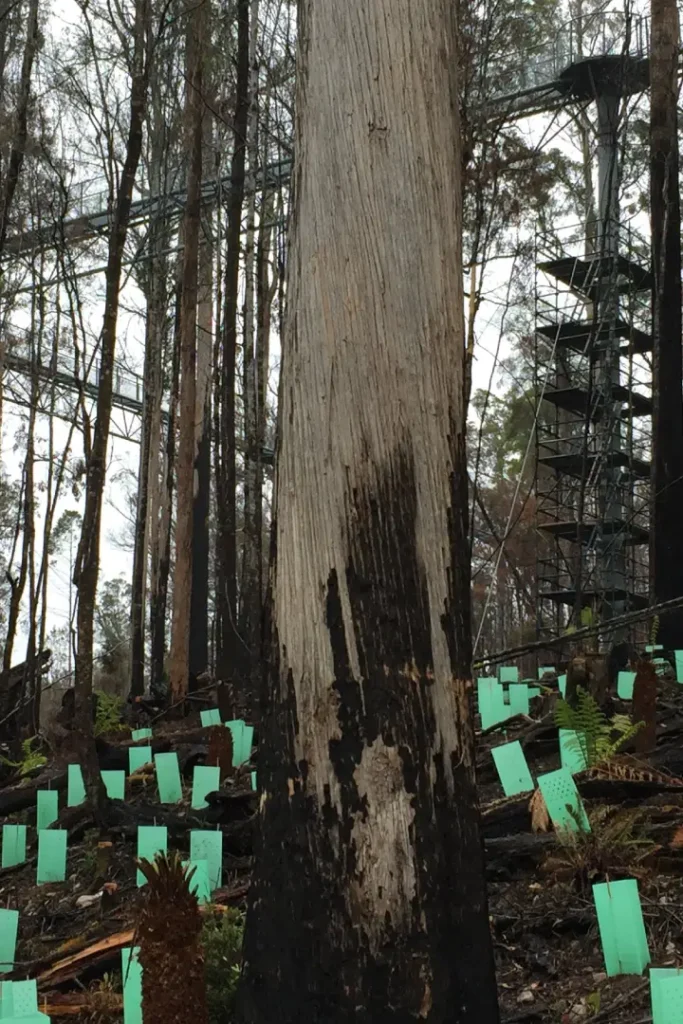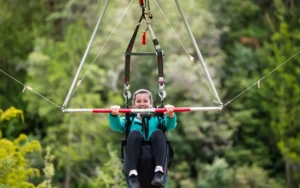
2019 BUSHFIRE
On 21st January, 2019, the Tahune Adventures site was evacuated by emergency due to incoming bushfire. This is the story of disaster and recovery.
The Story
On January 15th, 2019, dry lightning strikes ignited what is now called the Riveaux road fire in the Huon Valley.
The lightning strikes started multiple fires across the forests in South-West Tasmania. Within a few days they had joined together and began heading towards Tahune Adventures and the township of Geeveston.
On January 21st, the site of Tahune Adventures with over 300 guests was evacuated safely and quickly. Over the course of the following weeks, firefighters camped inside the Visitor Centre as they tirelessly fought the crawling fire that surrounded the site.

The fire moved in unusual and unpredictable patterns. There were times when it seemed to have passed, allowing us to think that we had gotten through relatively unscathed, until it looped back around again and swept through the forest that surrounded the Airwalk structure. The fire burned slow yet hot and destroyed a lot of the undergrowth. It’s interesting to see, even now years later, how the lower half of the trees were burned yet somehow the tops stayed green.
By mid-February 2019 the fire had burned 14,000 hectares (around 34.5 acres) and most people who lived in the southern parts of the Huon Valley had been evacuated. The PCYC in Huonville became an emergency shelter for evacuees without a place to go. Sadly, a few houses were destroyed in the blaze, but luckily no lives were lost. When the rain came almost three weeks after the fire began, all the residents of the Valley gave a collective sigh of relief.
When the fire had been fully extinguished, STT (Sustainable Timbers Tasmania) began the long haul of cleaning up and rebuilding around the reserve. About 4.5 kilometres of walking track was repaired or rebuilt. The entrance and exit of the Airwalk were redesigned and remade. Even though the actual structure wasn’t damaged at all, 992 metres of guywire and over 9000 bolts were replaced. To repaint the Airwalk, special scaffolding needed to be constructed to allow the painters access — they used around 2000 litres of paint. A brand-new pathway and steps to and from the Airwalk were created. Sadly, a lot of trees needed to be removed and trimmed due to instability and dying from the inside out. To replace them, over 8000 native plants were planted around the site.
After a year of recuperation, we were ready to be open again. On February 28th, 2020 Tahune Adventures welcomed visitors back.
Since the fires, it has been incredible to see the forest take back what once was lost. The undergrowth, shrubs, and ferns were the first to bounce back. The trees still standing began sprouting new lush green leaves within months. A lot of the area, untouched by fire, still showcases the beautiful landscape we have known and loved for years. And, in the parts where the burnt remnants can still be seen, a renewed and vast forest is taking shape.
Regeneration

Fire is a natural part of the wet forest lifecycle. Species that occur in these forests are adapted to fire, though rainforest species such as myrtle and sassafras will take a long time to return to their former glory following fire.
Eucalypts are reliant on fire for regeneration. Already around the site, small eucalypts can be seen growing from seeds dropped by the mature eucalypt trees. These will grow under the mature trees to form the next generation of the forest. Other species, including the early colonisers such as ferns and other scrub species, can also be seen starting to naturally regrow. Significant supplementary planting has been undertaken on site, to speed up the regeneration of the forest for visitors to enjoy. Species planted on site include leatherwood, celery top pine, and eucalypts.
As time goes on, the forest will become thicker and the rainforest species will continue to grow from seeds dropped by trees killed in the fire. Myrtle, sassafras, celerytop pine, and leatherwood usually grow as understorey species, under the shade provided by the eucalypts.
Around the site the eucalypts can be seem reshooting from their tree trunks, this is called epicormic growth. This growth is as a result of stress to the tree and helps the tree to survive by increasing the amount of photosynthesis.
The Story – written by Tahune Adventures
Regeneration – written by Sustainable Timbers Tasmania












